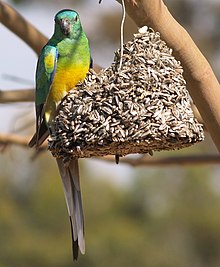Red Parakeet
| Red Parakeet | ||||||||||||
|---|---|---|---|---|---|---|---|---|---|---|---|---|

Singing Parakeets ( Psephotus haematonotus ), male |
||||||||||||
| Systematics | ||||||||||||
|
||||||||||||
| Scientific name | ||||||||||||
| Psephotus haematonotus | ||||||||||||
| ( Gould , 1837) |
The Sing parakeet ( Psephotus haematonotus ) is a parrot of the genus psephotus ( Psephotus ) within the family of authentics parrots (Psittacidae). Singing parakeets are found exclusively in southeast Australia. Their distribution area is predominantly inland. They are absent from Tasmania and the Bass Strait islands . The species is common and common and is one of the Australian parrot species that is expanding its range. You are the beneficiaries of the clearing when creating new agricultural areas.
Appearance
The singing parakeet reaches a body length of 27 centimeters and weighs between 50 and 85 grams. It is a slender, medium-sized parrot with a uniform back color and a long, stepped tail. As for all species of the Red Parakeet genus, there is a conspicuous sexual dimorphism.
The male of the red-winged parakeet is bluish green on the forehead, front parting and lower cheek region. The rest of the head plumage is green and turns into a yellowish green on the throat and chest. The cheek spots are only blurred. The anus region and the under tail cover are white. In some individuals, this part of the body is tinged with yellowish green. The rear neck as well as the back and the umbrella feathers are dull bluish green. The under wing coverts as well as the wing coverts, the hand coverts and the outer flags of the hand wings are purple blue. In contrast, the outer middle wing cover is yellow and the inner middle wing cover and the arm cover are blue-green. The rump is red. The upper tail-coverts are bright green. The beak is small, black, and not as strong as other species of the flat-tailed parakeet subfamily . the iris is brownish gray. The legs are greyish pink.
Females are dull greenish olive on the apex and on the top of the body. Only the rump and the upper tail covers are bright green. The forehead, the reins and the cheeks are gray to pale olive. The throat and upper chest are olive gray. The beak is dark gray. The iris is gray.
The flight of the singing parakeets is straight and relatively fast. Similar to grass parakeets , ringed parakeets fly distances at very high altitude, which is unusual for a bird that predominantly lives on the ground.
habitat
Singing Parakeets are birds of sparsely forested regions with a rich population of ripening grasses and herbaceous plants. They prefer to colonize tree savannahs, grasslands with scattered trees and open malls . They can also be found on partially cleared farmland and pastureland with remains of trees. On the other hand, they avoid more densely wooded habitats.
Singing parakeets have also adapted to urban habitats and can be seen in parks, gardens and sports fields with large lawns. Parakeets migrations have been described. However, this is mainly characteristic of that part of the population that populates the peripheral areas of the natural range. In the centers of the distribution area the ringed parakeet is a resident bird.
behavior
Singing parakeets live mainly on grass seeds and the seeds of herbaceous plants. The immature seed heads of the grape heron beak ( Erodium botrys ) are very often eaten by them . Seeds from trees and bushes only play a subordinate role in their diet. But they consume green parts of plants. The leaves of various types of thistle play a major role in this. They also eat flowers, berries and fruits.
Singing parakeets are cave breeders. The focus of the breeding season falls from late July to January. However, clutches are occupied from all months of the year, as they brood very quickly after extensive rainfall in the semi-arid areas of their range. The beginning of the breeding season is marked by an increasing dispute over breeding caves. There can be several nest holes in one tree. The pairs then only defend individual hollow branches or trunk sections against their conspecifics.
The clutch usually consists of five eggs. The nesting base is a layer of wooden mulm on the floor of the nesting cavity. The female breeds alone. The breeding season is 19 days. The male feeds the female during the breeding season.
supporting documents
literature
- Joseph M. Forshaw : Australian Parrots. 1st German-language edition. Volume 2, Arndt-Verlag, Bretten 2003, ISBN 3-9808245-2-7 .
Individual evidence
Web links
- Psephotus haematonotus inthe IUCN Red List of Threatened Species 2013.1. Listed by: BirdLife International, 2012. Retrieved September 28, 2013.
